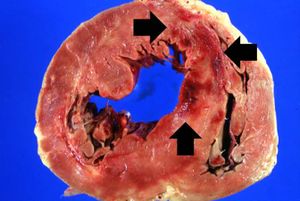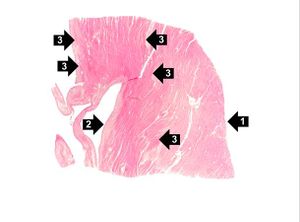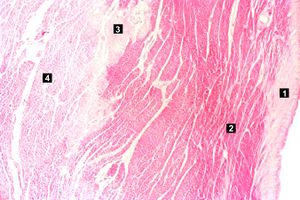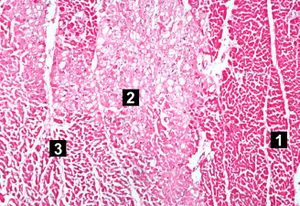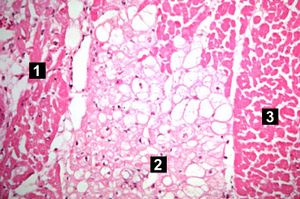Difference between revisions of "IPLab:Lab 1:Myocardial Infarction"
Seung Park (talk | contribs) |
Seung Park (talk | contribs) |
||
| Line 30: | Line 30: | ||
== Study Questions == | == Study Questions == | ||
| − | * What type of necrosis is present in this myocardial tissue? | + | * <spoiler text="What type of necrosis is present in this myocardial tissue?">Coagulative necrosis.</spoiler> |
| − | + | * <spoiler text="What are the morphologic characteristics of coagulative necrosis?">Hypereosinophilia, coagulation of cellular proteins, and loss of nuclei (pyknosis, karyolysis, and karyorrhexis).</spoiler> | |
| − | * What are the morphologic characteristics of coagulative necrosis? | + | * <spoiler text="What causes the vacuolar change seen in the tissue adjacent to this infarct and is this change reversible or irreversible injury?">The vacuolar change (hydropic change) seen in myocytes at the edge of an infarct is a REVERSIBLE CHANGE caused by CELLULAR EDEMA. |
| − | + | At the edge of an infarct the oxygen tension is low (hypoxia) so there is a decrease in oxidative metabolism and an increase in anaerobic glycolysis. Since anaerobic glycolysis is less efficient than aerobic metabolism there are lower ATP levels which result in impaired osmotic regulation. In addition, metabolic metabolites accumulate which further increases the intracellular osmotic load and leads to cellular edema.</spoiler> | |
| + | |||
| + | == Additional Resources == | ||
| + | |||
| + | === Reference === | ||
| + | * [http://emedicine.medscape.com/article/155919-overview eMedicine Medical Library: Myocardial Infarction] | ||
| + | * [http://www.merckmanuals.com/professional/cardiovascular_disorders/coronary_artery_disease/acute_coronary_syndromes_acs.html Merck Manual: Acute Coronary Syndromes] | ||
| + | |||
| + | == Journal Articles == | ||
| + | * Agnew NM, Pennefather SH, Russell GN. [http://onlinelibrary.wiley.com/doi/10.1046/j.1365-2044.2002.02469.x/full Isofluorane and coronary heart disease]. ''Anaesthesia'' 2002; 57(4): 338-347 | ||
{{Template:IPLab 1}} | {{Template:IPLab 1}} | ||
[[Category:IPLab]] | [[Category:IPLab]] | ||
Revision as of 14:43, 15 August 2013
Contents
Clinical Summary[edit]
This was a 57-year-old male whose hospital course following abdominal surgery was characterized by progressive deterioration and hypotension. Four days post-operatively, the patient sustained an anterior myocardial infarction and died the next day.
Autopsy Findings[edit]
The patient's heart weighed 410 grams. Examination of the coronary arteries revealed marked atherosclerotic narrowing of all three vessels with focal occlusion by a thrombus of the left anterior descending artery. Fresh necrosis of the anterior wall of the left ventricle and anterior portion of the septum was present, extending from the endocardium to the inner half of the ventricular wall.
Images[edit]
Study Questions[edit]
Additional Resources[edit]
Reference[edit]
Journal Articles[edit]
- Agnew NM, Pennefather SH, Russell GN. Isofluorane and coronary heart disease. Anaesthesia 2002; 57(4): 338-347
| |||||
Myocardial infarction is necrosis of myocardial tissue which occurs as a result of a deprivation of blood supply, and thus oxygen, to the heart tissue. Blockage of blood supply to the myocardium is caused by occlusion of a coronary artery.
A normal heart weighs 300 grams (range: 270 to 360 grams).
Atherosclerosis is the deposition of lipid into the intima of arteries, resulting in narrowing of the vessel lumen.
An occlusion is a blockage.
A thrombus is a solid mass resulting from the aggregation of blood constituents within the vascular system.
